
Movies Home / Entertainment Channel / Bullz-Eye Home
Science fiction is among the most creative of motion picture genres, where viewers are able to take flights of fancy into worlds of wonder…like, say, Pandora in "Avatar." That was cool, right? And, yet, there's something equally intriguing about taking that dark left turn into areas that haven't happened and probably won't happen…and, yet, there's this nagging sensation in the back of your brain that keeps reminding you that maybe, just maybe, they could happen. The idea of a world where humanity is on its last legs is one which has floated through art and literature for hundreds of years, but such concepts increased exponentially with the advent of the atomic bomb, and once Hollywood special effects began to catch up to the imaginations of filmmakers, you couldn't turn around without finding a new post-apocalyptic vision on the big screen. Here's a list of some of the most notable, along with a few of our personal favorites, but rest assured that there are many, many more where these came from.
 Planet of the Apes (1968)
Planet of the Apes (1968)
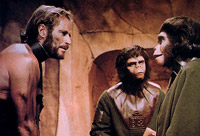 Though this isn't actually a best-to-worst list, "Planet of the Apes" was always going to be sitting at the top. Not only has it been the subject of countless pop culture parodies (admit it, "Simpsons" geeks: you've been singing "I hate every ape I see / From chimpan-A to chimpanzee" since you started reading) and contains one of the greatest movie lines of all time ("Take your stinking paws off me, you damn dirty ape!"), but it was a defining moment in late '60s science fiction, leaving a legacy that even Tim Burton's craptastic remake wasn't able to taint…much. Everyone knows the famous State of Liberty scene where Taylor (Charlton Heston) damns the maniacs all to hell for blowing up the planet, but Earth's real problem started with the plague that hit in 1983 (!), which killed off the majority of the planet's dogs and cats. After a suitable period of mourning, humanity turned to monkeys and apes as pets, a regrettable decision which quickly led to simian slave labor and the inevitable uprising. At this point, things get a little sketchy, but a nuclear exchange definitely took place, and it was all downhill for humanity after that…not that apekind didn't have its own troubles. (See "Battle for the Planet of the Apes" for details.) Good thing the mutants had the Alpha-Omega Bomb to serve as the great equalizer. Of course, their version of leveling the playing field involved leveling the entire planet, but, hey, you can't argue with those kinds of results. – Will Harris
Though this isn't actually a best-to-worst list, "Planet of the Apes" was always going to be sitting at the top. Not only has it been the subject of countless pop culture parodies (admit it, "Simpsons" geeks: you've been singing "I hate every ape I see / From chimpan-A to chimpanzee" since you started reading) and contains one of the greatest movie lines of all time ("Take your stinking paws off me, you damn dirty ape!"), but it was a defining moment in late '60s science fiction, leaving a legacy that even Tim Burton's craptastic remake wasn't able to taint…much. Everyone knows the famous State of Liberty scene where Taylor (Charlton Heston) damns the maniacs all to hell for blowing up the planet, but Earth's real problem started with the plague that hit in 1983 (!), which killed off the majority of the planet's dogs and cats. After a suitable period of mourning, humanity turned to monkeys and apes as pets, a regrettable decision which quickly led to simian slave labor and the inevitable uprising. At this point, things get a little sketchy, but a nuclear exchange definitely took place, and it was all downhill for humanity after that…not that apekind didn't have its own troubles. (See "Battle for the Planet of the Apes" for details.) Good thing the mutants had the Alpha-Omega Bomb to serve as the great equalizer. Of course, their version of leveling the playing field involved leveling the entire planet, but, hey, you can't argue with those kinds of results. – Will Harris
 Five (1951)
Five (1951)
 During the 1950s, when families were building fallout shelters in their backyards and kids were participating in "duck and cover" drills in public schools, you can imagine that the idea of a post-apocalyptic society was something that was being treated with deadly seriousness. Although "Five" isn't necessarily the best of the motion pictures that came out of this concern (that honor is better bestowed on 1959's "The World, The Flesh, and The Devil," starring Sidney Poitier, Inger Stevens, and Mel Ferrer), it's generally cited as the first. Written and directed by Arch Oboler, the film focuses on the survivors of an atomic bomb disaster…and, yes, there are just as many as you think there are. Or, at least, that's how it starts out, anyway. There's Roseanne (Susan Douglas Rubes), a pregnant wife who needs first-hand confirmation of her husband's fate before she'll accept it, Michael (William Phipps), the man she finds living in her aunt's house, Oliver (Earl Lee), an elderly bank clerk whose mind can't recognize the reality of the situation, Eric (James Anderson), a mountain climber on his way back from Mount Everest who barely survives his plane running out of fuel, and Charles (Charles Lampkin), an African-American man who provides the film with a message of racial tolerance rarely seen in that era. "Five" is a stark look at a situation that, at the time, Americans feared they might well find themselves experiencing for real, and even after almost 60 years, it still remains a powerful film. – WH
During the 1950s, when families were building fallout shelters in their backyards and kids were participating in "duck and cover" drills in public schools, you can imagine that the idea of a post-apocalyptic society was something that was being treated with deadly seriousness. Although "Five" isn't necessarily the best of the motion pictures that came out of this concern (that honor is better bestowed on 1959's "The World, The Flesh, and The Devil," starring Sidney Poitier, Inger Stevens, and Mel Ferrer), it's generally cited as the first. Written and directed by Arch Oboler, the film focuses on the survivors of an atomic bomb disaster…and, yes, there are just as many as you think there are. Or, at least, that's how it starts out, anyway. There's Roseanne (Susan Douglas Rubes), a pregnant wife who needs first-hand confirmation of her husband's fate before she'll accept it, Michael (William Phipps), the man she finds living in her aunt's house, Oliver (Earl Lee), an elderly bank clerk whose mind can't recognize the reality of the situation, Eric (James Anderson), a mountain climber on his way back from Mount Everest who barely survives his plane running out of fuel, and Charles (Charles Lampkin), an African-American man who provides the film with a message of racial tolerance rarely seen in that era. "Five" is a stark look at a situation that, at the time, Americans feared they might well find themselves experiencing for real, and even after almost 60 years, it still remains a powerful film. – WH
 The Omega Man (1971)
The Omega Man (1971)
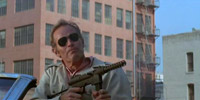 Richard Matheson's 1954 novel, "I Am Legend," has been adapted into film form three times, first in 1964 as "The Last Man on Earth," starring Vincent Price, and most recently in 2007, where it maintained its original title and found Will Smith in the leading role. Your mileage on the matter may vary, but we're partial to the (omega) man in the middle, where Charlton Heston plays U.S. Army Colonel Robert Neville, M.D., one of the few humans left in Los Angeles who hasn't succumbed to the effects of the biological warfare between the People's Republic of China and the Soviet Union either by dying or falling victim to a strange pigmentation-affecting mutation. That's not quite how things went down in the book (it was actually a plague that caused Earth's issues), but the effect is approximately the same, with Neville – who used himself as a guinea pig for a vaccine that turned out to work just fine, thank you – living a life of isolation. Soon, however, he finds a few uninfected folks, including Dutch (Paul Koslo) and Lisa (Rosalind Cash), the latter dressed such that we presume she was on her way to the auditions for "Sweet Sweetback's Baadasssss Song" when the warfare went down. The skirmish against the Family…that's what the united homicidal albino mutants call themselves…doesn't go so well for Neville, but thanks to the serum he derived from his blood prior to the final battle, at least the future of humanity looks a little bit brighter. – WH
Richard Matheson's 1954 novel, "I Am Legend," has been adapted into film form three times, first in 1964 as "The Last Man on Earth," starring Vincent Price, and most recently in 2007, where it maintained its original title and found Will Smith in the leading role. Your mileage on the matter may vary, but we're partial to the (omega) man in the middle, where Charlton Heston plays U.S. Army Colonel Robert Neville, M.D., one of the few humans left in Los Angeles who hasn't succumbed to the effects of the biological warfare between the People's Republic of China and the Soviet Union either by dying or falling victim to a strange pigmentation-affecting mutation. That's not quite how things went down in the book (it was actually a plague that caused Earth's issues), but the effect is approximately the same, with Neville – who used himself as a guinea pig for a vaccine that turned out to work just fine, thank you – living a life of isolation. Soon, however, he finds a few uninfected folks, including Dutch (Paul Koslo) and Lisa (Rosalind Cash), the latter dressed such that we presume she was on her way to the auditions for "Sweet Sweetback's Baadasssss Song" when the warfare went down. The skirmish against the Family…that's what the united homicidal albino mutants call themselves…doesn't go so well for Neville, but thanks to the serum he derived from his blood prior to the final battle, at least the future of humanity looks a little bit brighter. – WH
 A Boy and His Dog (1975)
A Boy and His Dog (1975)
 As the saying goes, if you need a friend in a post-nuclear wasteland, get a dog. That's especially true if you're a sociopathic, horny teenage male in need of an intelligent, telepathic canine's olfactory abilities for locating women. Females are especially rare in this particular apocalypse and consent is, we're sorry to say, a small matter to roving rapists growing up in the aftermath of World War IV -- ethics and compassion aren't exactly survival traits in this particular future. In this blackly comic Hugo-winning film adaptation of a Hugo-winning novella by science fiction writer Harlan Ellison directed by veteran western actor L.Q. Jones ("The Wild Bunch"), the boy is Vic (Don Johnson, a few years away from "Miami Vice") and the dog is a scruffy genetically enhanced mutt -- voiced by Tim McIntyre -- who happens to be vastly smarter than Vic or any other human onscreen. Billed as "a rather kinky tale of survival," the movie was a failure on its initial release only to become a cult success later on, and then only to be somewhat forgotten in our own time. Certainly, understandable accusations of misogyny -- even author Ellison claimed to be furious about the film's jokey last line -- haven't helped it. Still, let's face it, in a real apocalypse, guys like Vic, with or without the humanizing influence of a super-intelligent canine, would be a lot more common than, say, cynical but essentially honorable near superheroes named, say, Max. – Bob Westal
As the saying goes, if you need a friend in a post-nuclear wasteland, get a dog. That's especially true if you're a sociopathic, horny teenage male in need of an intelligent, telepathic canine's olfactory abilities for locating women. Females are especially rare in this particular apocalypse and consent is, we're sorry to say, a small matter to roving rapists growing up in the aftermath of World War IV -- ethics and compassion aren't exactly survival traits in this particular future. In this blackly comic Hugo-winning film adaptation of a Hugo-winning novella by science fiction writer Harlan Ellison directed by veteran western actor L.Q. Jones ("The Wild Bunch"), the boy is Vic (Don Johnson, a few years away from "Miami Vice") and the dog is a scruffy genetically enhanced mutt -- voiced by Tim McIntyre -- who happens to be vastly smarter than Vic or any other human onscreen. Billed as "a rather kinky tale of survival," the movie was a failure on its initial release only to become a cult success later on, and then only to be somewhat forgotten in our own time. Certainly, understandable accusations of misogyny -- even author Ellison claimed to be furious about the film's jokey last line -- haven't helped it. Still, let's face it, in a real apocalypse, guys like Vic, with or without the humanizing influence of a super-intelligent canine, would be a lot more common than, say, cynical but essentially honorable near superheroes named, say, Max. – Bob Westal
 Damnation Alley (1977)
Damnation Alley (1977)
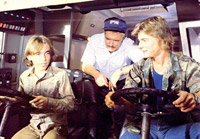 After viewing a clip from this lost classic on YouTube, someone was moved to wonder, "Why are the good post-apocalyptic movies all from the '70s and '80s?" You may be surprised to learn that this comment did not appear to be a facetious one…nor, for that matter, was our earlier description of the film as a lost classic. Released by 20th Century Fox in the wake of "Star Wars" after a disconcerting amount of post-production, "Damnation Alley" starts by revealing the path to Earth's nuclear devastation, then fast-forwards two years to show a planet that's been tilted off its axis and ravaged by radiation. So, basically, not only do you get really crappy weather, but you also get a whole lot of mutated insects. This means that the cast of the film – which, by the way, includes George Peppard, Jan-Michael Vincent, and Jackie Earle Haley – gets to ride around in an awesome-looking vehicle called the Landmaster. What's not to love? Well, possibly the fact that the budget can't possibly live up to the concepts set up in Roger Zelazny's original novel, which results in some rather dodgy special effects. Okay, so "Damnation Alley" isn't what you'd call a great film. It's still a fun one (we've got five words for you: flesh-stripping Madagascar hissing cockroaches), and given that it was originally presented in Sound 360, a high-impact surround sound process that was top of the line in the '70s, it's certainly one ripe for re-appreciation on today's home theater systems. – WH
After viewing a clip from this lost classic on YouTube, someone was moved to wonder, "Why are the good post-apocalyptic movies all from the '70s and '80s?" You may be surprised to learn that this comment did not appear to be a facetious one…nor, for that matter, was our earlier description of the film as a lost classic. Released by 20th Century Fox in the wake of "Star Wars" after a disconcerting amount of post-production, "Damnation Alley" starts by revealing the path to Earth's nuclear devastation, then fast-forwards two years to show a planet that's been tilted off its axis and ravaged by radiation. So, basically, not only do you get really crappy weather, but you also get a whole lot of mutated insects. This means that the cast of the film – which, by the way, includes George Peppard, Jan-Michael Vincent, and Jackie Earle Haley – gets to ride around in an awesome-looking vehicle called the Landmaster. What's not to love? Well, possibly the fact that the budget can't possibly live up to the concepts set up in Roger Zelazny's original novel, which results in some rather dodgy special effects. Okay, so "Damnation Alley" isn't what you'd call a great film. It's still a fun one (we've got five words for you: flesh-stripping Madagascar hissing cockroaches), and given that it was originally presented in Sound 360, a high-impact surround sound process that was top of the line in the '70s, it's certainly one ripe for re-appreciation on today's home theater systems. – WH
 Dawn of the Dead (1978)
Dawn of the Dead (1978)
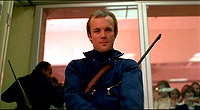 If you've ever looked around at the folks shuffling from shop to shop in your local mall, eyes glued to their iPhone screens between bouts of grazing the shop racks, and been reminded of brains-craving zombies, you can take it as a compliment that no less a zombie authority than George A. Romero himself had the same thought -- way back in 1978, when he followed up "Night of the Living Dead" with this tar-black satire of consumer culture, decades before most people even knew what consumer culture was. After the human race is devastated by a zombie plague, a small band of survivors takes refuge in a mall -- only to discover that not only are their flesh-eating pursuers annoyingly persistent, but that living in a shopping center is kind of a drag. There's some, ahem, meaty subtext in Romero's "Dawn," but even if none of that matters to you, it's still one of the smarter -- and, zombies notwithstanding, more believable -- post-apocalyptic thrillers to come out of Hollywood. And Romero did it all on a $500,000 budget, too! Imagine what he could have done with the "I Am Legend" catering budget. The saga continued with further "Dead" films, including "Day of the Dead" and "Land of the Dead," but "Dawn" is rightfully held up as Romero's zombie masterpiece. – Jeff Giles
If you've ever looked around at the folks shuffling from shop to shop in your local mall, eyes glued to their iPhone screens between bouts of grazing the shop racks, and been reminded of brains-craving zombies, you can take it as a compliment that no less a zombie authority than George A. Romero himself had the same thought -- way back in 1978, when he followed up "Night of the Living Dead" with this tar-black satire of consumer culture, decades before most people even knew what consumer culture was. After the human race is devastated by a zombie plague, a small band of survivors takes refuge in a mall -- only to discover that not only are their flesh-eating pursuers annoyingly persistent, but that living in a shopping center is kind of a drag. There's some, ahem, meaty subtext in Romero's "Dawn," but even if none of that matters to you, it's still one of the smarter -- and, zombies notwithstanding, more believable -- post-apocalyptic thrillers to come out of Hollywood. And Romero did it all on a $500,000 budget, too! Imagine what he could have done with the "I Am Legend" catering budget. The saga continued with further "Dead" films, including "Day of the Dead" and "Land of the Dead," but "Dawn" is rightfully held up as Romero's zombie masterpiece. – Jeff Giles
 The Road Warrior (1981)
The Road Warrior (1981)
 By the late seventies, post-nuclear apocalyptic landscapers were starting to become old hat, while the memory of the 1973 OPEC oil embargo and worldwide energy crisis that followed remained topical. The original "Mad Max" posited a world that was literally running out of gas and becoming increasingly desperate and ultra-violent. By the opening of George Miller's classic sequel with roots in western epics and silent films, dystopia has given way to full-blown apocalypse. Few seem to have survived the worldwide oil wars, save for groups of refugee pioneers attempting to deal with predatory punk-rock motorcycle gangs a bit closer to the hordes of Mordor than your standard Hell's Angels. Into this miasma comes Mel Gibson's iconic "burnt out...shell-of-a-man" who comes back into contact with the soul he lost in the prior film by going where countless reluctant screen heroes have gone before and helping the settlers in their attempt to reestablish something like civilization in the burnt-out outback, befriending a feral child (Emil Minty) and a dentally challenged autogyro pilot (Bruce Spence) in the process. Like a cowboy or a master-less samurai, Max wanders on, but what the disaster of a dead civilization has taken away from him, it's also given him to opportunity to partially reclaim. – BW
By the late seventies, post-nuclear apocalyptic landscapers were starting to become old hat, while the memory of the 1973 OPEC oil embargo and worldwide energy crisis that followed remained topical. The original "Mad Max" posited a world that was literally running out of gas and becoming increasingly desperate and ultra-violent. By the opening of George Miller's classic sequel with roots in western epics and silent films, dystopia has given way to full-blown apocalypse. Few seem to have survived the worldwide oil wars, save for groups of refugee pioneers attempting to deal with predatory punk-rock motorcycle gangs a bit closer to the hordes of Mordor than your standard Hell's Angels. Into this miasma comes Mel Gibson's iconic "burnt out...shell-of-a-man" who comes back into contact with the soul he lost in the prior film by going where countless reluctant screen heroes have gone before and helping the settlers in their attempt to reestablish something like civilization in the burnt-out outback, befriending a feral child (Emil Minty) and a dentally challenged autogyro pilot (Bruce Spence) in the process. Like a cowboy or a master-less samurai, Max wanders on, but what the disaster of a dead civilization has taken away from him, it's also given him to opportunity to partially reclaim. – BW
 Night of the Comet (1984)
Night of the Comet (1984)
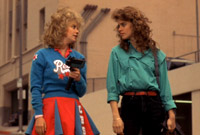 As a rule, rogue comets passing by our planet rarely result in anything good, but to have one turn almost everyone not under a steel-lined roof into red dust…? It was, as the film's poster assured us, the last thing on earth that sisters Regina and Samantha Belmont (Catherine Mary Stewart and Kelly Maroney) ever expected. "Night of the Comet" is generally thought of us as kitschy, and that's not an entirely inaccurate perception (cue the shopping montage set to "Girls Just Want To Have Fun"), but it's aged far better than most of the low-budget sci-fi / horror films of the era, offering unexpectedly effective scares (there's a particularly fun bit involving a nightmare which turns out to be taking place within another nightmare) and creating characters that end up far more fleshed out than the clichés they initially appear to be. The best examples of the latter come with the character of Hector (Robert Beltran), whose trip to check on the safety of his family is surprisingly touching, and through Mary Woronov's surprising poignant performance as a scientist who tries to do the right thing before succumbing to…uh, what exactly was she infected with? The science of "Night of the Comet" is more than a little dodgy, never bothering to offer an explanation as to why some people turned to dust while others became zombies, but in the end, you're provided with such an awesome artifact of the '80s that you find yourself forgiving the film its flaws. – WH
As a rule, rogue comets passing by our planet rarely result in anything good, but to have one turn almost everyone not under a steel-lined roof into red dust…? It was, as the film's poster assured us, the last thing on earth that sisters Regina and Samantha Belmont (Catherine Mary Stewart and Kelly Maroney) ever expected. "Night of the Comet" is generally thought of us as kitschy, and that's not an entirely inaccurate perception (cue the shopping montage set to "Girls Just Want To Have Fun"), but it's aged far better than most of the low-budget sci-fi / horror films of the era, offering unexpectedly effective scares (there's a particularly fun bit involving a nightmare which turns out to be taking place within another nightmare) and creating characters that end up far more fleshed out than the clichés they initially appear to be. The best examples of the latter come with the character of Hector (Robert Beltran), whose trip to check on the safety of his family is surprisingly touching, and through Mary Woronov's surprising poignant performance as a scientist who tries to do the right thing before succumbing to…uh, what exactly was she infected with? The science of "Night of the Comet" is more than a little dodgy, never bothering to offer an explanation as to why some people turned to dust while others became zombies, but in the end, you're provided with such an awesome artifact of the '80s that you find yourself forgiving the film its flaws. – WH
 When the Wind Blows (1986)
When the Wind Blows (1986)
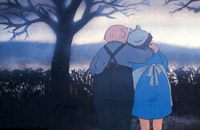 Moving from the ridiculous to the sublime, let us look at possibly the most depressing animated film you'll ever see. Though it's likely known more to Americans because of its soundtrack, which features contributions from David Bowie, Roger Waters, and Genesis, this adaptation of Raymond Briggs' graphic novel offers a look at how an elderly couple deals with an impending nuclear war and its inevitable aftermath, focusing on how little hope that such survivors would likely have. Sir John Mills and Dame Peggy Ashcroft provide the voices of the couple, who put their utmost faith in everything the government has told them about how to survive an attack, and having survived World War II, they manage to keep their spirits up even while preparing for the worst. Alas, faith serves them poorly: promises of post-attack government assistance of food and fresh water come to naught, leaving them to collect rain water and ultimately succumb to the ravages of radiation sickness. Director Jimmy Murakami does make time for flashback sequences to establish the longstanding love the couple have for each other (you may find yourself reminded of the beginning of "Up"), but it only makes the excruciating trip to the finale of the film all the more harrowing. No, it's not a film for children…and not just because things move at a slow, studied pace that would put pre-teens to sleep. The statement made by "When the Wind Blows" is one that still proves all too familiar today: war is Hell. – WH
Moving from the ridiculous to the sublime, let us look at possibly the most depressing animated film you'll ever see. Though it's likely known more to Americans because of its soundtrack, which features contributions from David Bowie, Roger Waters, and Genesis, this adaptation of Raymond Briggs' graphic novel offers a look at how an elderly couple deals with an impending nuclear war and its inevitable aftermath, focusing on how little hope that such survivors would likely have. Sir John Mills and Dame Peggy Ashcroft provide the voices of the couple, who put their utmost faith in everything the government has told them about how to survive an attack, and having survived World War II, they manage to keep their spirits up even while preparing for the worst. Alas, faith serves them poorly: promises of post-attack government assistance of food and fresh water come to naught, leaving them to collect rain water and ultimately succumb to the ravages of radiation sickness. Director Jimmy Murakami does make time for flashback sequences to establish the longstanding love the couple have for each other (you may find yourself reminded of the beginning of "Up"), but it only makes the excruciating trip to the finale of the film all the more harrowing. No, it's not a film for children…and not just because things move at a slow, studied pace that would put pre-teens to sleep. The statement made by "When the Wind Blows" is one that still proves all too familiar today: war is Hell. – WH
 12 Monkeys (1995)
12 Monkeys (1995)
 The future looks pretty grim in Terry Gilliam's sole foray into the realm of science fiction. (No, "Brazil" isn't sci-fi; it was satire, but these days it's looking more and more like reality.) The population of planet Earth has been nearly wiped out by a virus, and the few that have survived have moved underground; it's a hazily portrayed existence, yet there's no question that life for humanity is bleak at best. The surface of the planet remains as it was, only overrun by animals of all kinds (which is given an explanation later in the movie). The government and scientists have turned their efforts toward perfecting time travel, and have managed to cobble together a crude technique, which is where prisoner James Cole (Bruce Willis) enters the picture. He's sent to the past (numerous times) in order to find out more about the virus's origins. There he meets mental patient Jeffrey Goines (Brad Pitt, in an Oscar-nominated performance), who may very well have something to do with the end of the world as we know it. As the story moves forward, it becomes one of those time travel meditations that says nothing can be done to change the past, and no matter how hard you try, you'll inevitably find yourself becoming part of the timeline. The film, based on the 1962 short "La Jetée," was dazzling in its day, and remains a potent concoction of sci-fi, memories and madness 15 years later. It also unfortunately marks the last time Gilliam had a box office hit. – Ross Ruediger
The future looks pretty grim in Terry Gilliam's sole foray into the realm of science fiction. (No, "Brazil" isn't sci-fi; it was satire, but these days it's looking more and more like reality.) The population of planet Earth has been nearly wiped out by a virus, and the few that have survived have moved underground; it's a hazily portrayed existence, yet there's no question that life for humanity is bleak at best. The surface of the planet remains as it was, only overrun by animals of all kinds (which is given an explanation later in the movie). The government and scientists have turned their efforts toward perfecting time travel, and have managed to cobble together a crude technique, which is where prisoner James Cole (Bruce Willis) enters the picture. He's sent to the past (numerous times) in order to find out more about the virus's origins. There he meets mental patient Jeffrey Goines (Brad Pitt, in an Oscar-nominated performance), who may very well have something to do with the end of the world as we know it. As the story moves forward, it becomes one of those time travel meditations that says nothing can be done to change the past, and no matter how hard you try, you'll inevitably find yourself becoming part of the timeline. The film, based on the 1962 short "La Jetée," was dazzling in its day, and remains a potent concoction of sci-fi, memories and madness 15 years later. It also unfortunately marks the last time Gilliam had a box office hit. – Ross Ruediger
 Six String Samurai (1998)
Six String Samurai (1998)
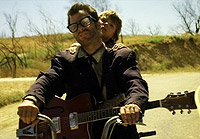 What if the Soviet Union had launched a series of warheads at the United States in 1957? That's the intriguing question posed by "Six-String Samurai" – but the movie doesn't stop there. Instead, writer-director Lance Mungia adds another layer, using his vision of a shattered post-nuclear American landscape as the backdrop for an action thriller version of the battle between traditional music (country, mariachi), rock & roll, and metal. It sounds bizarre, and it is, but it works; the "Six-String Samurai" in question, played by co-screenwriter Jeffrey Falcon, is a katana-wielding Buddy Holly lookalike (aptly named Buddy) who wages war against a Slash-resembling, metal-cranking warlord who's bent on conquering "Last Vegas." A Sundance sensation in '98, "Samurai" never really did the kind of business promised by all the hype surrounding the film, and Mungia didn't direct again until he helmed a "Crow" direct-to-video sequel in 2005 (talk about your apocalypses). Still, it's a fun flick, and if your interests include the end of the world and rock 'n' roll, you can hardly do better than this. – JG
What if the Soviet Union had launched a series of warheads at the United States in 1957? That's the intriguing question posed by "Six-String Samurai" – but the movie doesn't stop there. Instead, writer-director Lance Mungia adds another layer, using his vision of a shattered post-nuclear American landscape as the backdrop for an action thriller version of the battle between traditional music (country, mariachi), rock & roll, and metal. It sounds bizarre, and it is, but it works; the "Six-String Samurai" in question, played by co-screenwriter Jeffrey Falcon, is a katana-wielding Buddy Holly lookalike (aptly named Buddy) who wages war against a Slash-resembling, metal-cranking warlord who's bent on conquering "Last Vegas." A Sundance sensation in '98, "Samurai" never really did the kind of business promised by all the hype surrounding the film, and Mungia didn't direct again until he helmed a "Crow" direct-to-video sequel in 2005 (talk about your apocalypses). Still, it's a fun flick, and if your interests include the end of the world and rock 'n' roll, you can hardly do better than this. – JG
 The Matrix (1999)
The Matrix (1999)
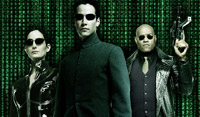 The idea of mankind enslaved by some malevolent force or another is an old favorite with moviemakers (Aliens! Bugs! Apes!), as is the idea of people being, um, repurposed, as it were. (Two words: Soylent Green.) "The Matrix" is one of the only movies to combine the two concepts, though when the movie begins, neither of them is apparent. Indeed, the world of Tom Anderson, a worker drone by day and uber-hacker Neo by night, seems pretty unremarkable. It is only after hacker cult figure Morpheus agrees to show Tom "how deep the rabbit hole goes" that Tom, and we, learn The Ugly Truth: the surface of the earth has been uninhabitable for centuries, and all humans are spending their lives in a virtual reality construct, while a complex network of machines uses the electrical energy and body heat from their real bodies, which are stored in individual pods, as a fuel source. Whoa. Curiously, the film was so eager to show off its knowledge of philosophy, Hong Kong cinema and bullet-cam techniques that it spent very little time exploring one very simple question: what price freedom? Obviously no one wants to fuel the machines that enslaved humanity, but then again, choosing life outside of the Matrix is a lot like choosing life in "The Road," minus the cannibals. (For now, anyway.) And after seeing the food that the crew of the Nebuchadnezzar ate, and the ratty conditions of the humans' promised land of Zion, that imaginary steak Agent Smith "fed" Cypher would have looked damn good to us, too. – David Medsker
The idea of mankind enslaved by some malevolent force or another is an old favorite with moviemakers (Aliens! Bugs! Apes!), as is the idea of people being, um, repurposed, as it were. (Two words: Soylent Green.) "The Matrix" is one of the only movies to combine the two concepts, though when the movie begins, neither of them is apparent. Indeed, the world of Tom Anderson, a worker drone by day and uber-hacker Neo by night, seems pretty unremarkable. It is only after hacker cult figure Morpheus agrees to show Tom "how deep the rabbit hole goes" that Tom, and we, learn The Ugly Truth: the surface of the earth has been uninhabitable for centuries, and all humans are spending their lives in a virtual reality construct, while a complex network of machines uses the electrical energy and body heat from their real bodies, which are stored in individual pods, as a fuel source. Whoa. Curiously, the film was so eager to show off its knowledge of philosophy, Hong Kong cinema and bullet-cam techniques that it spent very little time exploring one very simple question: what price freedom? Obviously no one wants to fuel the machines that enslaved humanity, but then again, choosing life outside of the Matrix is a lot like choosing life in "The Road," minus the cannibals. (For now, anyway.) And after seeing the food that the crew of the Nebuchadnezzar ate, and the ratty conditions of the humans' promised land of Zion, that imaginary steak Agent Smith "fed" Cypher would have looked damn good to us, too. – David Medsker
 Children of Men (2006)
Children of Men (2006)
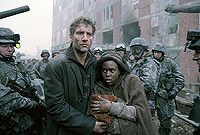 What would happen to our world if we had everything we currently have, minus just one thing: a future? The answer portrayed in this involving, grimly violent, and hugely moving film by Alfonso Cuaron, based on a novel by P.D. James, is a bleak one indeed. Fascism, vicious anti-immigration policies, poverty, and mindless warfare are just a few of the plagues visited upon humanity by itself after realizing that it has -- for no clear reason -- lost the ability to reproduce. In the middle of all this is Theo Faron (Clive Owen at his most Bogart-esque), a tragedy-scarred activist-turned-bureaucrat who would prefer not to stick his neck out for anyone but who nevertheless finds the courage to do the right thing. In this case, that means helping a vulnerable young African immigrant (Claire-Hope Ashitey) who is the only known person to have become pregnant in eighteen years and who has therefore become a pawn in a political game being played by some extremely callous players. It's an increasingly deadly journey, including one of the most viscerally frightening battle sequences since "Saving Private Ryan." Still, it's a battle that must be endured. Apocalypses may come and go, but as long as there are children, there is hope. – BW
What would happen to our world if we had everything we currently have, minus just one thing: a future? The answer portrayed in this involving, grimly violent, and hugely moving film by Alfonso Cuaron, based on a novel by P.D. James, is a bleak one indeed. Fascism, vicious anti-immigration policies, poverty, and mindless warfare are just a few of the plagues visited upon humanity by itself after realizing that it has -- for no clear reason -- lost the ability to reproduce. In the middle of all this is Theo Faron (Clive Owen at his most Bogart-esque), a tragedy-scarred activist-turned-bureaucrat who would prefer not to stick his neck out for anyone but who nevertheless finds the courage to do the right thing. In this case, that means helping a vulnerable young African immigrant (Claire-Hope Ashitey) who is the only known person to have become pregnant in eighteen years and who has therefore become a pawn in a political game being played by some extremely callous players. It's an increasingly deadly journey, including one of the most viscerally frightening battle sequences since "Saving Private Ryan." Still, it's a battle that must be endured. Apocalypses may come and go, but as long as there are children, there is hope. – BW
 Terminator Salvation (2009)
Terminator Salvation (2009)
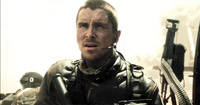 The tales of the "Terminator" universe will give you a headache if you try to make sense of all the time travel shenanigans, but one thing's for sure: the future definitely isn't looking too bright for humanity. But why, you ask, have we gone with the least of the films as our designated selection when all the other entries in the franchise feature glimpses of a future involving the so-called "Rise of the Machines"? Simple: it's the only one that takes place almost exclusively during that era. "Salvation" is all about the human resistance forces fighting against the forces of Skynet, the computer system which took its artificial intelligence, said, "Screw this," and revolted against its creators (an event which would come to be known as Judgment Day). It also gives us the first full-fledged look at resistance fighter John Connor in action as an adult and provides us with more details about the Terminators' evolution, their shift away from pure robotics, and the incorporation of living tissue into their matrix. Still, we can't very well ignore the preceding films, especially since they're all about trying to keep the events in "Salvation" from coming to pass in the first place. Although the ostensible purpose of "Salvation" was to fill a gap in the franchise's history by showing more of the devastation caused by Skynet's uprising, it's arguable that we had a lot more dread about what was on the horizon when we were only seeing the future in small doses. – WH
The tales of the "Terminator" universe will give you a headache if you try to make sense of all the time travel shenanigans, but one thing's for sure: the future definitely isn't looking too bright for humanity. But why, you ask, have we gone with the least of the films as our designated selection when all the other entries in the franchise feature glimpses of a future involving the so-called "Rise of the Machines"? Simple: it's the only one that takes place almost exclusively during that era. "Salvation" is all about the human resistance forces fighting against the forces of Skynet, the computer system which took its artificial intelligence, said, "Screw this," and revolted against its creators (an event which would come to be known as Judgment Day). It also gives us the first full-fledged look at resistance fighter John Connor in action as an adult and provides us with more details about the Terminators' evolution, their shift away from pure robotics, and the incorporation of living tissue into their matrix. Still, we can't very well ignore the preceding films, especially since they're all about trying to keep the events in "Salvation" from coming to pass in the first place. Although the ostensible purpose of "Salvation" was to fill a gap in the franchise's history by showing more of the devastation caused by Skynet's uprising, it's arguable that we had a lot more dread about what was on the horizon when we were only seeing the future in small doses. – WH
 Battlefield: Earth (2000)
Battlefield: Earth (2000)
 Much as "Planet of the Apes" was always destined to sit atop this list, so was it secured long ago that "Battlefield Earth" would be at the bottom…because, really, where else would you put the film which took home the Razzie for Worst Picture of the Decade? There had been attempts to bring L. Ron Hubbard's 1982 novel to the big screen since its publication, but it took the power of a post-"Pulp Fiction" John Travolta to finally make it happen…and once it did happen, all but the most diehard Scientologists likely wished that it hadn't. "Battlefield Earth" paints a picture of an Earth that's been under alien rule for a millennium, but humanity finally battles back against the so-called Psychlos, thanks to the man known as Jonnie Goodboy Tyler (Barry Pepper). Y'see, Earth apparently isn't the greatest post, which is why the Psychlo charged with handling the security of the planet – Terl, played by Travolta – got his job as a form of punishment. Frustrated with the situation, Terl devises a plan to buy his way out by getting human slaves to mine huge amounts of gold from a highly radioactive area, but he makes the mistake of selecting Jonnie as his foreman. The next thing you know, there's a major uprising, Terl ends up imprisoned in Fort Knox, and the humans are in charge again. Yay, Earth! Some say "Battlefield" failed at the box office because of an anti-Scientology backlash. Don't you believe them: it bombed because it's terrible. – WH
Much as "Planet of the Apes" was always destined to sit atop this list, so was it secured long ago that "Battlefield Earth" would be at the bottom…because, really, where else would you put the film which took home the Razzie for Worst Picture of the Decade? There had been attempts to bring L. Ron Hubbard's 1982 novel to the big screen since its publication, but it took the power of a post-"Pulp Fiction" John Travolta to finally make it happen…and once it did happen, all but the most diehard Scientologists likely wished that it hadn't. "Battlefield Earth" paints a picture of an Earth that's been under alien rule for a millennium, but humanity finally battles back against the so-called Psychlos, thanks to the man known as Jonnie Goodboy Tyler (Barry Pepper). Y'see, Earth apparently isn't the greatest post, which is why the Psychlo charged with handling the security of the planet – Terl, played by Travolta – got his job as a form of punishment. Frustrated with the situation, Terl devises a plan to buy his way out by getting human slaves to mine huge amounts of gold from a highly radioactive area, but he makes the mistake of selecting Jonnie as his foreman. The next thing you know, there's a major uprising, Terl ends up imprisoned in Fort Knox, and the humans are in charge again. Yay, Earth! Some say "Battlefield" failed at the box office because of an anti-Scientology backlash. Don't you believe them: it bombed because it's terrible. – WH
You can follow us on Twitter and Facebook for content updates. Also, sign up for our email list for weekly updates and check us out on Google+ as well.











